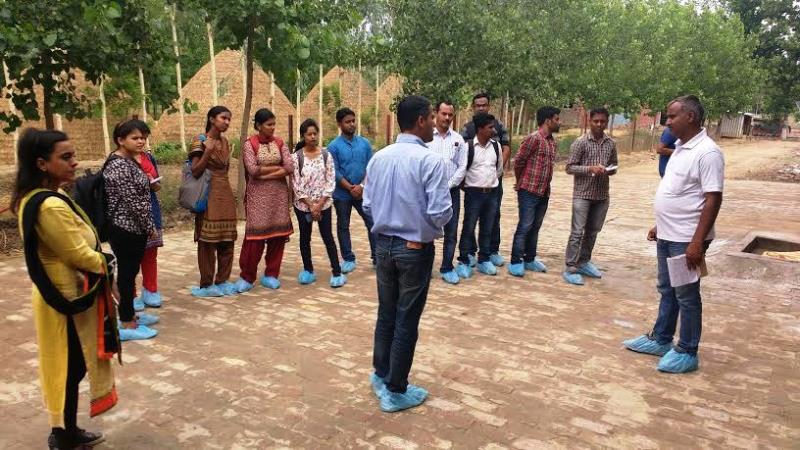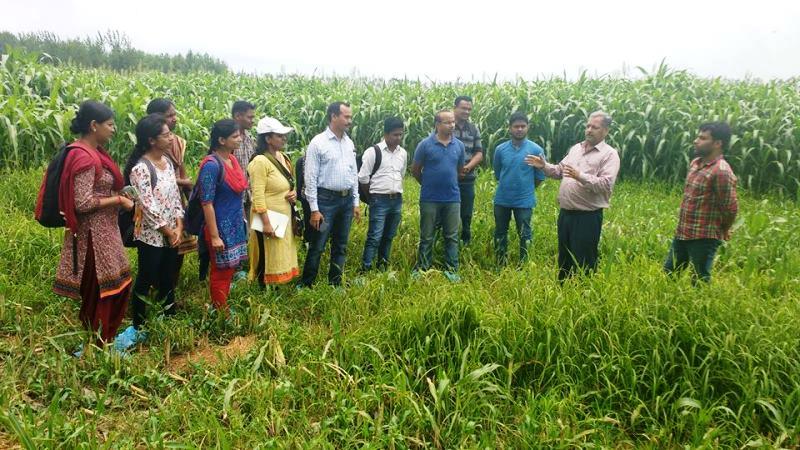
Last Saturday, along with thirteen Veterinary post-graduates, I traveled to Chaudhary Farms of Ms Nikki Pilania Chaudhary, finalist in GFAR’s Youth Agripreneurs Project (YAP). The practical exposure to doctoral students enrolled for two courses in Entrepreneurial Development and Extension Management was my primary motivation for this visit. I had read about Nikki and her project, and, in my first guest blog for GFAR , I had profiled Ms Nikki as one among the several emerging role models for farmers. I was curious to know more about her project and farming experiences, so mailed her my wish to visit her farm. She instantly agreed, to my pleasure!
These students doing the course on Entrepreneurship Development and Extension Management were theoretically oriented on entrepreneurship through classroom lectures. I have been coordinating this compulsory audit course Entrepreneurship Development since 2009 at ICAR- Indian Veterinary Research Institute. All the students admitted to my institute have to do this two-credit theory course (we may reconsider making it 1 theory 1 practical, as it was initially). For these students, there was no opportunity to better understand or have a practical idea of what an Agripreneur is and how agripreneurs are different from rest of the farmers. I believe courses like this without any field orientation don’t make much sense. The students’ feedback, too, urged more practical opportunities in this course. It being just 65 km from my institute, there was no better option for me, than taking them to Nikki’s Farm. The students were quite excited to meet this agripreneur in action. Obviously for me, too, this was one great opportunity. This visit, thus, was loaded with reasons!

We were warmly welcomed at around 10.30AM by Nikki and her husband Gaurav Chaudhary on our arrival to Chaudhary Farms—a 70 acre well-diversified farm with cereals, fodder crops, dairy, sugarcane, mango orchard and agroforestry. The first impression itself was an eye opener, when all of us were offered and asked to wear disposable plastic foot-coverings over our shoes as bio-security measure (what we normally read only in text books). This is not practiced in many livestock farms, at least in developing world, so it was the first great lesson from this Agripreneur.
We saw the herd of well-maintained high-yielding dairy cows of Holestein breed at this farm. While on the way, non-descript low yielding dairy animals were seen in plenty, grazing in the fields across several villages. In our stay of about 3 hrs, Ms Nikki narrated her plans to enrich her dairy herd with promising native dairy breeds like Gir. She had been to Gujarat recently in search of pedigreed cows of this breed. In coming days she wants to stock Gir cows for multiplication and distribution among local farmers. Her project, especially her interventions in the areas of animal feeding and management ensuring the cows’ comfort, looked attractive to the visiting veterinary students.

We could see the clear difference in the ways she does farming, for instance:
►Keeping an improved breed of proven potential
►Fodder cultivation: Fodder maize has been replaced by sugar graze, while clover by rye grass
►Better housing: scientifically designed to ensure cow comfort
►Better health care: Prompt attention to animal health needs
►Smart milk processing, value addition, branding & marketing plan in offing
The students queried her, “why does she want to switch to Gir breed when she is doing so well with Holestein?” Nikki replied that she can’t recommend these high yielders to small scale farmers who are in big majority in India. The high yielders need high investment in feed & fodder, health care, housing etc, which small scale Indian farmers can hardly afford. She found Gir most promising among 40 odd Indian native cattle breeds, which Indian farmers can rear profitably.
In the short period of just 5 years in the dairying business, Nikki and Gaurav have acquired amazing experience including technical knowledge. She told us that average profitable lactations are not more than 3 in case of exotic cattle, while heat tolerant indigenous cows like Gir are capable of giving on average 8 lactations with fewer inputs and minimum risk. We were highly impressed by the grasp of technical issues in animal feeding and management though they did not have any formal qualifications in dairying or livestock management, just like most of Indian farmers.

In this farm we saw that clover has been totally replaced by rye grass, though clover is very popular in the region for a long time. Likewise, fodder maize has been totally replaced by sugar graze, which is not much known yet in the region. Mr Gaurav gave very convincing reasons for making these fodder crop changes in his farm, which could be good for other farmers in this region, too. He says, apart from keeping promising dairy breeds, animal nutrition including ration balancing, choice of feeds and fodder is crucial to make dairying a profitable venture. There are no doubts about what he says. Appreciably, he was keen to collaborate with animal scientists to make dairy farming even more profitable.
The seed funding that Ms Nikki has received through the Youth Agripreneurs Project (YAP) is surely going to strengthen her to better her farm and other farmers in India. We left her farm with memories of good farming practices worth sharing with our colleagues back at our institute, as also with the farmers we extensionists meet frequently. In future, my institute may consider making visits of this kind to enterprising farmers, part of the core content of the course on Entrepreneurship Development.
The Saturday was spent very fruitfully at the farm of a YAP!!!

Guest blog post by Mahesh Chander (drmahesh.chander(at)gmail.com), Head, Division of Extension Education, ICAR- Indian Veterinary Research Institute
The views expressed are personal, and cannot be attributed to ICAR or GFAR.
Photo credits: Mahesh Chander



It was very satisfying experience for us! more photos can be found here: https://www.facebook.com/photo.php?fbid=1030092323712688&set=pcb.1289683924393737&type=3&theater
https://drive.google.com/file/d/0B0TX5SvS4lMRalczTGxTV2JiU3c/view
https://drive.google.com/file/d/0B0TX5SvS4lMRNFMtQnY5ZHRDekk/view
https://drive.google.com/file/d/0B0TX5SvS4lMRVzJjRUQ2T2NDZUU/view
Very nicely written the whole experience sir. I also got facinated toward Nikki”s intiatives in livestock sector, which a veterinary graduate harly adopt. I also gone through her project in YAP contest. She is really a role model for young entrepreneurs. Thanks to you to give a brief picture of her farm & simultaneously motivating the students to get a practical exposure of all the learnings
Amazing work ma dia….. am also good in feedind n nutrition back here in kenya…u need help on that feel free to ask. +254726202501. Hv used urea molasses block? There very good in boosting degestion n boosting milk production n also butter fat boost
Waoooh gud job. Am also in dairy…. I make ubm blocks that r better than the normal blocks. They contain protein n help in digestion of fodder n cut 60 of the fodders waste thro undigested to dug…boost fertility n milk let down.call +254726202501
Nice blog sir
Very informative blog sir…..nice agriprenure ….. motivational
I’m really happy for this young farming couple. may they keep inspiring other agriprenuers
its very interesting to know about Ms Nikki and her farm, who is an agripreneur. its very much appreciable that she would like to promote and prove the potential of Gir breed Cow of India. and also keeping in view of small scale farmers who cannot afford higher costs in livestock management. Now the Govt. of India is also keen to promote desi cattle and Centre has been assisting states in setting up ‘Gokul Gram’ (integrated indigenous cattle centers) that would scientifically help local farmers conserve ‘desi’ breeds of cows and buffaloes in view of threat of decline in milk production due to effect of global warming and high raising temperatures on high yield cross-bred cows and buffaloes. Indian dairy scientists estimate that climate change will lead to decline in milk production by over 3 million tonnes (MT) per year by 2020. (http://timesofindia.indiatimes.com/india/Government-to-milk-desi-cows-in-climate-fight/articleshow/52392821.cms).
Though not a Veterinarian, she has acquired all the technical knowledge focusing on all aspects including bio-security measures. Unemployed youth/Veterinary graduate those who are keen to go for livestock enterprises can take her as a role model for sustaining in the respective enterprises and to be successful.
I wish her all the best in her future endeavors.
I congratulate Dr Mahesh Chander for taking his students to that farm to have the exposure. Among them agripreneurs may arise! – Dr.Subrahmayeswari, Professor, NTR College of Veterinary Science, Gannavaram, Andhra Pradesh, India.
Thank you all for your encouraging comments on the blog.
It was a wonderful experience for me Sir. I learned many new ideas and ways to maintain a dairy farm practically apart from whatever written in books. Thanks for organizing that visit.